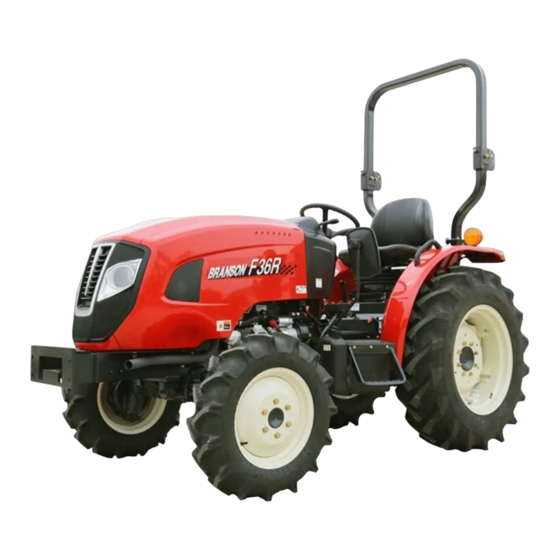
Table of Contents
Advertisement
Quick Links
This operator's manual contains handling tips and precautions for safe operation of your TYM.F25R(H),Rn(hn)/
F36R(H),Rn(hn)/F42R(H),.Rn(hn)/F50R(H),.Rn(hn).tractor. Read it carefully before you operate your tractor and
make sure that you have a full understanding of this manual. This will ensure correct operation and to keep the
tractor optimum condition.
After reading the manual, keep it close to the tractor for immediate reference. When you loan your tractor to some-
one else, loan the manual as well.
In case the manual is lost or damaged, please contact your local authorized dealer for a copy. Some parts of this
product may have been changed for the improvement of quality or for safety reasons, in which case the photo-
graphs or drawings of the parts in this booklet may not be the same as the actual parts installed on this product. If
you fi nd anything in this manual unclear or need further explanation, please contact your authorized dealer.
※ Regarding the purpose of this machine
Do not modify the machine or try to do the job which is beyond purpose of this machine. Otherwise it may cause the war-
ranty cancellation. (Refer to warranty statement for detail)
PREFACE
Advertisement
Chapters
Table of Contents

Summarization of Contents
1. For Safe Operation
Safety Precautions
Instructions and warnings to prevent accidents and injuries during tractor operation.
Decal Mounting Location
Diagrams showing the placement of various safety and informational decals on the tractor.
Decals
Identification and meaning of specific warning and caution decals found on the tractor.
Cautions for Decal Maintenance
Guidelines for keeping decals clean, intact, and properly affixed to the tractor.
2. Regarding Warranty Support
Regarding Warranty Certificate
Information concerning the warranty certificate and its coverage.
Regarding After-Sales Service
Details on obtaining after-sales service and support for the tractor.
Vehicle Identification Number (VIN)
Locating and understanding the tractor's unique Vehicle Identification Number (VIN).
Regarding Supplying Service Parts
Information on the availability and procurement of official service parts.
Regarding Genuine Parts and Fluid
Emphasis on using genuine TYM parts and fluids for safety and performance.
3. Specifications
Major Specifications
Detailed technical specifications including engine, capacity, and dimensions for various models.
Driving Speed
Table outlining forward and reverse driving speeds for different ranges and models.
4. Operation Description
Exterior Views
Identification of external components and parts of the tractor through labeled diagrams.
Switches and Levers
Description and function of various switches and levers located on the steering column.
Instrument Cluster
Explanation of indicators, gauges, and meters on the tractor's instrument panel.
Controls 1
Details on foot-operated controls, including pedals for brakes and propulsion.
Controls 2
Details on hand-operated controls for shifting, PTO, and differential lock.
5. Operation
Daily Inspection Before Starting
Procedures for checking essential fluid levels and greasing points before daily operation.
Pre-Operation Check
Important checks and warm-up procedures before starting the tractor's engine.
Starting Engine
Step-by-step guide on how to safely start the tractor's engine.
Tractor Operation
Guidelines for operating the tractor, including driving, towing, and handling weight.
Stopping Engine
Procedures for safely stopping the tractor's engine and preparing for shutdown.
Attachment of Implement
Instructions on how to properly attach and adjust implements to the tractor's hitch system.
Control and Operation of Hydraulic System
Explanation of hydraulic system controls, hoses, and connectors for implements.
6. Maintenance
Maintenance Schedule Chart
Recommended maintenance intervals for various tractor components based on hours or years.
Fluids and Capacity
Details on required fluids, their capacities, and specifications for the tractor.
Routine Maintenance
Procedures for regular checks and replacements, including engine oil and transmission fluid.
Checking Fuel Filter Water Separator
Procedure for draining accumulated moisture from the fuel filter water separator.
Checking Exhaust Gas
Interpreting exhaust gas color to diagnose potential engine issues.
Checking Fuse and Fusible Link
Guidelines for inspecting and replacing fuses and fusible links in the tractor's electrical system.
Checking and Adjusting Toe-in
Procedure for checking and adjusting the front wheel alignment (toe-in) for proper steering.
Checking and Adjusting Fan Belt
Instructions on inspecting and adjusting the tension of the fan belt.
7. Troubleshooting
Troubleshooting - Engine
Common engine symptoms and their potential causes and corrective actions.
Troubleshooting - Clutch and Brake
Diagnosing and resolving issues related to the tractor's clutch and brake systems.
Troubleshooting - Hydraulic System
Identifying and fixing problems with the tractor's hydraulic system and implement control.
Troubleshooting - Electrical System
Diagnosing and resolving issues with the tractor's lights, signals, and other electrical components.
8. Storage and Disposal
Daily Storage
Proper procedures for storing the tractor after daily use, including cleaning and protection.
Long-Term Storage
Guidelines for preparing and storing the tractor for extended periods of non-use.
Operating Tractor After Long-Term Storage
Steps to take to safely prepare and operate the tractor after it has been stored long-term.
Usage and Disposal
Recommendations for environmentally responsible usage and disposal of the tractor and its fluids.





Need help?
Do you have a question about the F50R and is the answer not in the manual?
Questions and answers